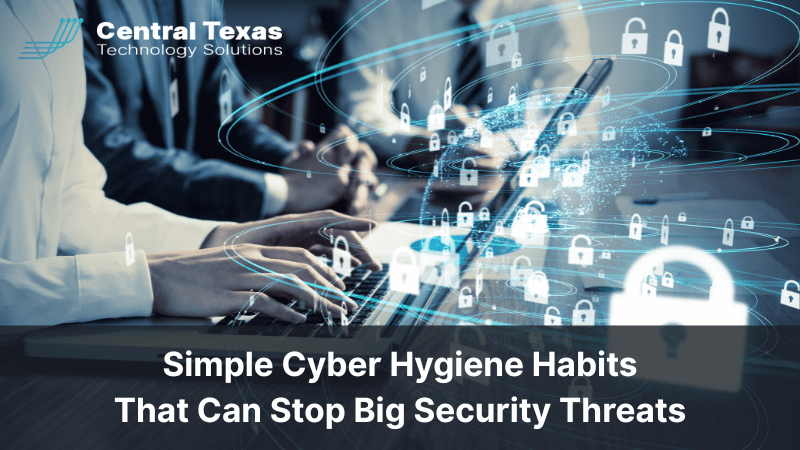
In today’s digital-first world, every business, regardless of size or industry, is a potential target for cybercriminals. One click on a suspicious link, one weak password, or one outdated system can be all it takes to open the door to a serious security breach.
Cyber hygiene is your business’s first defense. Think of it like brushing your teeth. You do it every day to prevent long-term damage. The same concept applies to your digital environment. When you and your team practice good cyber hygiene, you dramatically reduce your risk of falling victim to ransomware, data breaches, or phishing scams.
Below are practical steps that every business can take to strengthen its cybersecurity posture and stay protected against today’s most common threats.
Strengthen Login Access with Smarter Habits
The easiest way into your business’s systems is through weak login credentials. Hackers rely on users reusing passwords, using predictable information, or avoiding multifactor authentication altogether.
Here’s how to make access tougher for the bad guys:
- Never use common passwords like "password123" or "admin"
- Avoid including personal information such as birthdays or pet names
- Change passwords regularly and use a different one for each account
- Enable multi-factor authentication (MFA) wherever available
- Consider using a secure password manager to generate and store credentials
Keep All Software Up to Date
Cyber attackers often exploit known vulnerabilities in outdated software. Thankfully, software developers frequently release updates and patches to fix these holes. But they only work if you apply them.
To stay secure:
- Turn on automatic updates for your operating system, browsers, and applications
- Set antivirus software to update daily
- Regularly review and update firmware on network devices like routers and firewalls
Outdated software is low-hanging fruit for cybercriminals—don’t make yourself an easy target.
Think Before You Click
Phishing remains one of the most common and effective cyberattack methods. It only takes one employee clicking on a fake link or downloading a malicious file to cause massive damage.
Stay alert by watching for:
- Emails or texts with generic greetings like “Dear Customer”
- Spelling and grammar mistakes that raise red flags
- Unusual requests to reset passwords or verify sensitive information
- Messages that create a sense of urgency or panic
- Suspicious links or attachments from unknown senders
Train your team to pause, question, and verify before clicking anything that seems even slightly off.
Back Up Your Data the Smart Way
Even with solid prevention methods, things can still go wrong. That’s why having a robust data backup strategy is essential. It allows your business to recover quickly after an incident—without major losses.
Follow these best practices:
- Use a combination of cloud-based and offline backups
- Schedule automatic daily or weekly backups
- Test your backups regularly to ensure data can be restored successfully
- Keep at least one backup copy off-site or in the cloud
Having multiple copies of your critical data gives you flexibility and peace of mind.
Use Antivirus Software as a Safety Net
Firewalls built into modern systems do a good job, but they’re not enough on their own. A reliable antivirus solution adds an extra layer of defense by detecting and removing threats before they can spread.
Here’s what to look for:
- Choose antivirus software from a trusted, reputable provider
- Ensure it includes real-time scanning and automatic threat detection
- Update it regularly so it stays effective against new threats
This is a small investment that can prevent costly damage.
Stay Off Public Wi-Fi When Accessing Sensitive Information
Public Wi-Fi might be convenient, but it’s a major security risk. Hackers often monitor unsecured networks to steal login credentials or sensitive data.
To reduce this risk:
- Use a VPN (Virtual Private Network) if public Wi-Fi is your only option
- Avoid logging into banking or company accounts on public networks
- Use your mobile hotspot for a safer connection
Public networks are shared, and you never know who’s watching.
Build a Culture of Cyber Awareness
Cyber hygiene is not a one-time task. It’s an ongoing commitment. As your business grows and technology evolves, so do the threats. The good news is that when your team is educated, alert, and consistent with simple best practices, you stay one step ahead of attackers.
Creating a strong cybersecurity foundation isn’t just about technology—it’s about building smart habits and a culture of caution.
Frequently Asked Questions About Cyber Hygiene
1. What is cyber hygiene, and why does it matter?
Cyber hygiene refers to routine practices that help maintain the health and security of your digital systems. Like personal hygiene, it reduces risk and prevents problems before they happen.
2. How often should we update passwords and software?
Passwords should be changed every 60 to 90 days. Software should be updated as soon as patches or updates become available, ideally with auto-updates turned on.
3. Is antivirus software still necessary if we use cloud services?
Yes. Cloud platforms still rely on your devices for access. If your endpoint is compromised, your cloud data could be at risk. Antivirus helps protect those entry points.
Want help building a cyber hygiene checklist tailored to your business? Contact CTTS today to strengthen your security strategy.
Contact CTTS today for IT support and managed services in Austin, TX. Let us handle your IT so you can focus on growing your business. Visit CTTSonline.com or call us at (512) 388-5559 to get started!
